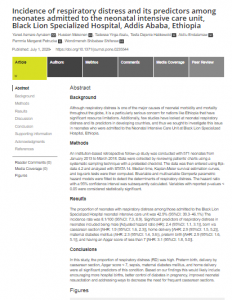
Background
Although respiratory distress is one of the major causes of neonatal morbidity and mortality throughout the globe, it is a particularly serious concern for nations like Ethiopia that have significant resource limitations. Additionally, few studies have looked at neonatal respiratory distress and its predictors in developing countries, and thus we sought to investigate this issue in neonates who were admitted to the Neonatal Intensive Care Unit at Black Lion Specialized Hospital, Ethiopia.
Methods
An institution-based retrospective follow-up study was conducted with 571 neonates from January 2013 to March 2018. Data were collected by reviewing patients’ charts using a systematic sampling technique with a pretested checklist. The data was then entered using Epi-data 4.2 and analyzed with STATA 14. Median time, Kaplan-Meier survival estimation curves, and log-rank tests were then computed. Bivariable and multivariable Gompertz parametric hazard models were fitted to detect the determinants of respiratory distress. The hazard ratio with a 95% confidence interval was subsequently calculated. Variables with reported p-values < 0.05 were considered statistically significant.
Results
The proportion of neonates with respiratory distress among those admitted to the Black Lion Specialized Hospital neonatal intensive care unit was 42.9% (95%CI: 39.3–46.1%) The incidence rate was 8.1/100 (95%CI: 7.3, 8.9). Significant predictors of respiratory distress in neonates included being male [Adjusted hazard ratio (HR): 2.4 (95%CI: 1.1, 3.1)], born via caesarean section [AHR: 1.9 (95%CI: 1.6, 2.3)], home delivery [AHR: 2.9 (95%CI: 1.5, 5,2)], maternal diabetes mellitus (AHR: 2.3 (95%CI: 1.4, 3.6)), preterm birth [AHR: 2.9 (95%CI: 1.6, 5.1)], and having an Apgar score of less than 7 [AHR: 3.1 (95%CI: 1.8, 5.0)].